Last and final part in our Iya Trilogy
After a slow casual start over the weekend, we finally kicked into full-Iya tourism mode on Saturday night:
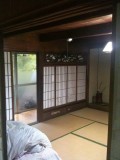 First, was a night at Ueda-san’s lovely B&B in a traditional farmhouse: 200 year-old chestnut-wood house, large washitsu with circling corridors, relaxing stone-lined ofuro and mellow family vibe. When I eventually buy my house in the Japanese countryside, this is probably what it will look like.
First, was a night at Ueda-san’s lovely B&B in a traditional farmhouse: 200 year-old chestnut-wood house, large washitsu with circling corridors, relaxing stone-lined ofuro and mellow family vibe. When I eventually buy my house in the Japanese countryside, this is probably what it will look like.
 Even though some the charm of the above amenities was lost on my travelling buddies (particularly the awesome onsen-sized Japanese bath: a little “too exposed to the outside” for their modesty) and Ueda-san’s exclusive use of Japanese required a bit of translating back-and-forth with the group, everybody came together on the homemade, fresh-from-the-farm fruit, veggie and goat-milk yoghurt breakie… followed by a formal introduction to the goats themselves. As it turns out, milking a goat is not easy at all, but I can now add that to my short list of skills that might come handy, should civilisation crumble and send us all back to the bronze age.
Even though some the charm of the above amenities was lost on my travelling buddies (particularly the awesome onsen-sized Japanese bath: a little “too exposed to the outside” for their modesty) and Ueda-san’s exclusive use of Japanese required a bit of translating back-and-forth with the group, everybody came together on the homemade, fresh-from-the-farm fruit, veggie and goat-milk yoghurt breakie… followed by a formal introduction to the goats themselves. As it turns out, milking a goat is not easy at all, but I can now add that to my short list of skills that might come handy, should civilisation crumble and send us all back to the bronze age.
Sunday was the day we had picked for finally touring Iya proper.
 Since it is virtually impossible to see much without a car (and even then: preferably with an experienced driver and a certain disregard for one’s life given the relatively high likelihood to end up as a bundle of metal and bones 300m down a cliff), we went for the touristy guided tour package [en]: an all-inclusive day-long bus ride up and down the river, stopping for sights or cultural activities every 30 minutes or so. Altogether, quite tolerable and fun for a guided bus tour, in good part thanks to the bus itself being a very improbable vintage 1950s “Bonnet” bus, and the duo of laconic yet thankfully skillful bus-driving ojisan and cheerful obasan guide (who worriedly inquired about ours being fine with the Japanese-only nature of the tour, then went on proudly announcing to the 20-some seated passengers that “3 americans visitors” were gracing them with their presence on that day).
Since it is virtually impossible to see much without a car (and even then: preferably with an experienced driver and a certain disregard for one’s life given the relatively high likelihood to end up as a bundle of metal and bones 300m down a cliff), we went for the touristy guided tour package [en]: an all-inclusive day-long bus ride up and down the river, stopping for sights or cultural activities every 30 minutes or so. Altogether, quite tolerable and fun for a guided bus tour, in good part thanks to the bus itself being a very improbable vintage 1950s “Bonnet” bus, and the duo of laconic yet thankfully skillful bus-driving ojisan and cheerful obasan guide (who worriedly inquired about ours being fine with the Japanese-only nature of the tour, then went on proudly announcing to the 20-some seated passengers that “3 americans visitors” were gracing them with their presence on that day).
 Of course, some parts of the tour were somewhat forgettable, such as the 30 minutes visit to the “museum of stone and minerals”, that had unexplainably be enhanced by a sub-exhibit dedicated to monsters from Japanese folk stories (fun, and season-appropriate, but not really at the top of our Iya checklist). But mostly, it was good fun and breathtaking views while driving along the scary mountain roads of Iya (about once every 10 minutes, the bus had to stop at some particularly narrow turn and either back up or wait for some incoming car to do so until we could go).
Of course, some parts of the tour were somewhat forgettable, such as the 30 minutes visit to the “museum of stone and minerals”, that had unexplainably be enhanced by a sub-exhibit dedicated to monsters from Japanese folk stories (fun, and season-appropriate, but not really at the top of our Iya checklist). But mostly, it was good fun and breathtaking views while driving along the scary mountain roads of Iya (about once every 10 minutes, the bus had to stop at some particularly narrow turn and either back up or wait for some incoming car to do so until we could go).
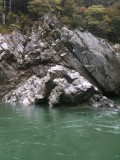 The boat ride at the bottom of the gorge was unsurprisingly beautiful, made even cooler by the previous night’s strong rain sprouting a thousand waterfalls all along the canyon. Somehow, all the rock masses lining the river are at the same rough 45 degree angle: I couldn’t catch the boat driver’s explanation of why that is…
The boat ride at the bottom of the gorge was unsurprisingly beautiful, made even cooler by the previous night’s strong rain sprouting a thousand waterfalls all along the canyon. Somehow, all the rock masses lining the river are at the same rough 45 degree angle: I couldn’t catch the boat driver’s explanation of why that is…
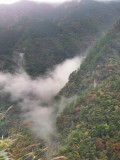 After a lunch of Iya soba with vegetables and grilled fish, we made a brief stop to gawk at aforementioned minerals and papier-maché monsters, then another at the modest Heikei Yashiki “Museum of Folklore”.
After a lunch of Iya soba with vegetables and grilled fish, we made a brief stop to gawk at aforementioned minerals and papier-maché monsters, then another at the modest Heikei Yashiki “Museum of Folklore”.
While the distant episode of Japanese history attached to the place understandably did not rouse much enthusiasm in my two travel buddies, I was busy patting myself on the back for accidentally understanding most of the convoluted Japanese terms involved in the discussion: thanks to an informal lunch conversation with work colleagues the week before, it only took me half the bus ride there to understand that the ‘hei’ (平) in ‘Heike’ (平家) was none other than the ‘Taira’ (平) in ‘Taira clan’, while the ‘gen’ (源) in ‘Genji’ (源氏) was of course the very ‘Minamoto’ from ‘Minamoto clan’, making it then obvious then that the ‘Genpei’ (源平) war opposed the Minamoto (源) and Taira (平) clans. If the preceding sentence makes no sense to you whatsoever, consider yourself a lucky person and keep staying as far away from Japanese language studies as you can.
 Amongst random bits of trivia imparted personally on me by our guide during a side-conversation: the colours of the Taira clan (red) and Minamoto clan (white) went on to become the official colours of modern Japan. Upon learning that I lived in Kyoto, she surprised me by mentioning Alex Kerr and seemed to take pride in Iya being his official retreat, far from the encroachment of modern Japanese urban life. I regret not getting a chance to ask her what she thought of his vocal positions on the state of Japan and its cultural heritage.
Amongst random bits of trivia imparted personally on me by our guide during a side-conversation: the colours of the Taira clan (red) and Minamoto clan (white) went on to become the official colours of modern Japan. Upon learning that I lived in Kyoto, she surprised me by mentioning Alex Kerr and seemed to take pride in Iya being his official retreat, far from the encroachment of modern Japanese urban life. I regret not getting a chance to ask her what she thought of his vocal positions on the state of Japan and its cultural heritage.
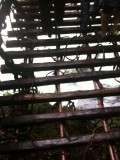 The rest of our tour included perennial stops at one of Iya’s vine bridges (the crossing of which was a suitably scary experience, even with the knowledge that the vines were steel-reinforced, these days) and the vertiginous view from the top, near the Shōbenkozō (小便小僧) statue: Iya’s answer to Brussels’ boringly sea-level Mannekin Pis. All along increasingly steeper and more serpentine roads, and recurrent near-misses with incoming cars.
The rest of our tour included perennial stops at one of Iya’s vine bridges (the crossing of which was a suitably scary experience, even with the knowledge that the vines were steel-reinforced, these days) and the vertiginous view from the top, near the Shōbenkozō (小便小僧) statue: Iya’s answer to Brussels’ boringly sea-level Mannekin Pis. All along increasingly steeper and more serpentine roads, and recurrent near-misses with incoming cars.
Finally back in Miyoshi-shi’s comparatively bustling metropolis (with its sprawling 5-store mall and local train line to Tokushima-shi), we filled our last two hours with random food sampling, mandatory omiyage shopping1While not finding options more specific than generic “Tokushima-ken candies” as local souvenirs was a bit of an annoyance, it may have been a blessed sign that the region has not entirely been taken over by generic tourism yet. and the odd black-ops mission to the Middle-East at the game arcade. As it turned out, there is a direct bus connection (roughly 4-5 a day) between Awa Ikeda and Osaka: not the fastest (about 4h), but a great option to avoid having to rush back early to Tokushima-shi to catch the last bus to Kyoto.
While appreciation for Iya Valley might depend heavily on one’s enjoyment of remote rural places (I do enjoy them, if only for a short period at a time) and comfort with the Japanese language (English will only take you that far), I would definitely recommend the place to anyone looking to see more than the usual pre-packaged city temple and stays at “traditional” ryokan in ageing 1980s architectural horrors2Cue “3 Most Beautiful Views of Japan”, “5 Most Amazing Wooden Structures” and all the other empty promises of Japanese tourism.. If spending a week there (with a car) to take time exploring and hiking around is not an option, it is still a perfect destination for a weekend excursion from Kansai: in fact, we could probably have managed equally well, leaving Kyoto for Tokushima-shi on Saturday morning and getting to Awa Ikeda around the time we did (albeit with a much earlier wake-up than we had).
Now go and turn this unexpectedly-preserved oasis of Japanese Nature into the over-developed touristic urban wasteland that it deserves to be, fellow travellers!
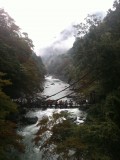
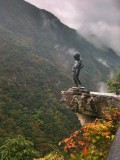
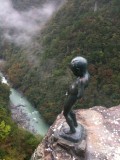
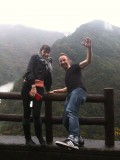
Spent a lovely week in that area about 8 years ago. The vine bridges were wonderful. The scenery magnificent. Spent a few days at Chiiori (Alex Kerr’s place) and that was OK.